Wntβ-catenin signaling mediates the antitumor activity of magnolol
Wntβ-catenin信号通路在胚胎癌细胞增殖中的作用及其机制研究的开题报告
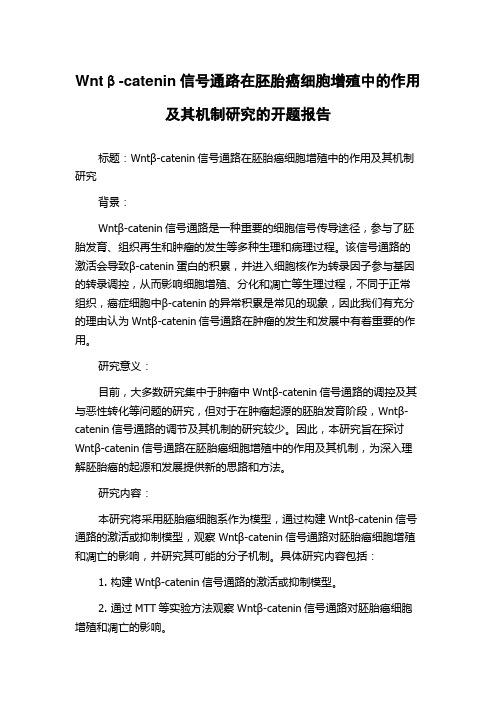
Wntβ-catenin信号通路在胚胎癌细胞增殖中的作用及其机制研究的开题报告标题:Wntβ-catenin信号通路在胚胎癌细胞增殖中的作用及其机制研究背景:Wntβ-catenin信号通路是一种重要的细胞信号传导途径,参与了胚胎发育、组织再生和肿瘤的发生等多种生理和病理过程。
该信号通路的激活会导致β-catenin蛋白的积累,并进入细胞核作为转录因子参与基因的转录调控,从而影响细胞增殖、分化和凋亡等生理过程,不同于正常组织,癌症细胞中β-catenin的异常积累是常见的现象,因此我们有充分的理由认为Wntβ-catenin信号通路在肿瘤的发生和发展中有着重要的作用。
研究意义:目前,大多数研究集中于肿瘤中Wntβ-catenin信号通路的调控及其与恶性转化等问题的研究,但对于在肿瘤起源的胚胎发育阶段,Wntβ-catenin信号通路的调节及其机制的研究较少。
因此,本研究旨在探讨Wntβ-catenin信号通路在胚胎癌细胞增殖中的作用及其机制,为深入理解胚胎癌的起源和发展提供新的思路和方法。
研究内容:本研究将采用胚胎癌细胞系作为模型,通过构建Wntβ-catenin信号通路的激活或抑制模型,观察Wntβ-catenin信号通路对胚胎癌细胞增殖和凋亡的影响,并研究其可能的分子机制。
具体研究内容包括:1. 构建Wntβ-catenin信号通路的激活或抑制模型。
2. 通过MTT等实验方法观察Wntβ-catenin信号通路对胚胎癌细胞增殖和凋亡的影响。
3. 检测β-catenin在细胞中的表达及其在信号通路中的位置。
4. 通过RNA干扰技术等手段研究Wntβ-catenin信号通路对细胞生长的基因调控作用。
预期结果:1. 成功构建Wntβ-catenin信号通路不同调控模型,如激活或抑制。
2. 观察到Wntβ-catenin信号通路对胚胎癌细胞增殖和凋亡的影响。
3. 确定β-catenin在信号通路中的位置及其在细胞中的表达。
wnt/β-catenin 信号通路相关蛋白在卵巢癌中的改变
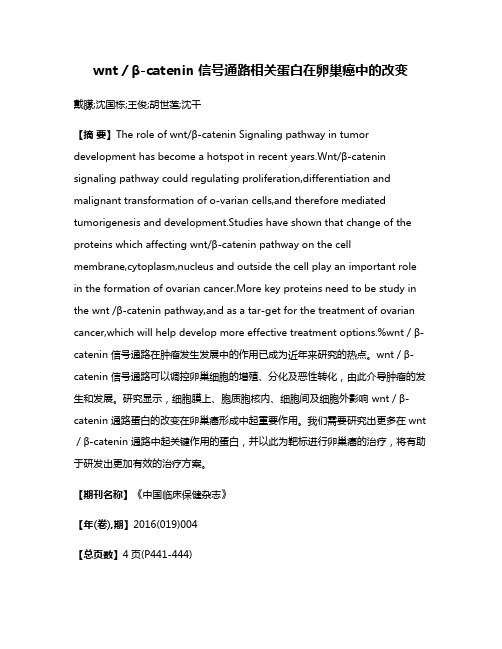
wnt/β-catenin 信号通路相关蛋白在卵巢癌中的改变戴朦;沈国栋;王俊;胡世莲;沈干【摘要】The role of wnt/β-catenin Signaling pathway in tumor development has become a hotspot in recent years.Wnt/β-catenin signaling pathway could regulating proliferation,differentiation and malignant transformation of o-varian cells,and therefore mediated tumorigenesis and development.Studies have shown that change of the proteins which affecting wnt/β-catenin pathway on the cell membrane,cytoplasm,nucleus and outside the cell play an important role in the formation of ovarian cancer.More key proteins need to be study in the wnt /β-catenin pathway,and as a tar-get for the treatment of ovarian cancer,which will help develop more effective treatment options.%wnt/β-catenin 信号通路在肿瘤发生发展中的作用已成为近年来研究的热点。
wnt/β-catenin 信号通路可以调控卵巢细胞的增殖、分化及恶性转化,由此介导肿瘤的发生和发展。
研究显示,细胞膜上、胞质胞核内、细胞间及细胞外影响 wnt/β-catenin 通路蛋白的改变在卵巢癌形成中起重要作用。
Wntβ-catenin信号通路对毛囊干细胞定向分化的影响

Wntβ-catenin信号通路对毛囊干细胞定向分化的影响概述中国医学科学院医院整形外科医院数字化整形外科技术中心主任,颌面整形外科中心主任医师杨斌教授在Plastic andAesthetic Research期刊发表了一篇关于Wnt/β-catenin信号通路对毛囊干细胞定向分化的影响。
该项研究结果表明,LiCl能在体外诱导HFSCs分化为毛囊细胞,对皮肤损伤具有重要的治疗作用。
详细内容如下:目的毛囊干细胞(HFSCs)可分化为毛囊细胞,在临床上能应用于皮肤烧伤的治疗。
然而,调节HFSCs分化为毛乳头或表皮细胞的具体机制目前尚不清楚。
本研究主要探讨Wnt/β-catenin信号通路在HFSCs 分化中的作用及其对其他信号通路的影响。
方法应用氯化锂(LiCl,10 mmol/L)和角质细胞生长因子(KGF,10μg/L)分别诱导HFSC分化,并通过免疫荧光分析检测。
并在诱导后的第3、5、7、9天分别检测β-catenin、APC基因、糖原合成酶激酶-3(GSK-3β)、轴蛋白、淋巴样增强因子-1的mRNA表达以研究Wnt/β-catenin信号通路的作用。
结果在LiCl诱导HFSCs分化为毛囊细胞的过程中,Wnt/β-catenin信号通路激活,GSK-3β(降解过程中的一个重要化合物)的表达受到抑制。
这导致了细胞质中β-catenin的表达增加,细胞核异位,进而导致靶基因转录。
相比之下,KGF诱导HFSCs分化为表皮细胞,且不影响β-catenin的表达。
这些数据表明LiCl和KGF能分别调节HFSCs分化为毛囊细胞和表皮细胞。
此外,Wnt/β-catenin信号通路在毛囊细胞分化中具有重要的作用。
结论结果表明,LiCl能在体外诱导HFSCs分化为毛囊细胞,对皮肤损伤具有重要的治疗作用。
引用方式Yang B, Wu XY, Ni J, Li BH, Deng LH, Xiang MJ. Modulation ofWnt/β-catenin signaling affects the directional differentiation of hairfollicle stem cells. Plast Aesthet Res 2016; 3:39-46.。
Wnt 信号通路在人胎盘滋养层细胞侵袭、分化过程中的研究进展
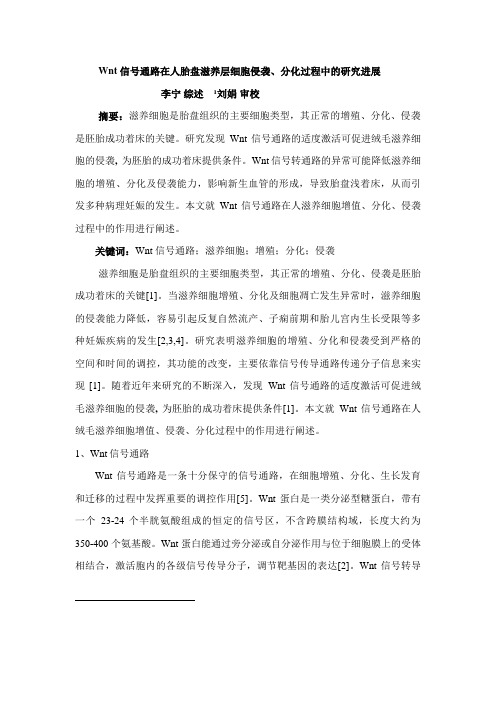
Wnt 信号通路在人胎盘滋养层细胞侵袭、分化过程中的研究进展李宁综述1刘娟审校摘要:滋养细胞是胎盘组织的主要细胞类型,其正常的增殖、分化、侵袭是胚胎成功着床的关键。
研究发现Wnt 信号通路的适度激活可促进绒毛滋养细胞的侵袭, 为胚胎的成功着床提供条件。
Wnt信号转通路的异常可能降低滋养细胞的增殖、分化及侵袭能力,影响新生血管的形成,导致胎盘浅着床,从而引发多种病理妊娠的发生。
本文就Wnt 信号通路在人滋养细胞增值、分化、侵袭过程中的作用进行阐述。
关键词:Wnt 信号通路;滋养细胞;增殖;分化;侵袭滋养细胞是胎盘组织的主要细胞类型,其正常的增殖、分化、侵袭是胚胎成功着床的关键[1]。
当滋养细胞增殖、分化及细胞凋亡发生异常时,滋养细胞的侵袭能力降低,容易引起反复自然流产、子痫前期和胎儿宫内生长受限等多种妊娠疾病的发生[2,3,4]。
研究表明滋养细胞的增殖、分化和侵袭受到严格的空间和时间的调控,其功能的改变,主要依靠信号传导通路传递分子信息来实现[1]。
随着近年来研究的不断深入,发现Wnt 信号通路的适度激活可促进绒毛滋养细胞的侵袭, 为胚胎的成功着床提供条件[1]。
本文就Wnt 信号通路在人绒毛滋养细胞增值、侵袭、分化过程中的作用进行阐述。
1、Wnt信号通路Wnt 信号通路是一条十分保守的信号通路,在细胞增殖、分化、生长发育和迁移的过程中发挥重要的调控作用[5]。
Wnt蛋白是一类分泌型糖蛋白,带有一个23-24个半胱氨酸组成的恒定的信号区,不含跨膜结构域,长度大约为350-400个氨基酸。
Wnt蛋白能通过旁分泌或自分泌作用与位于细胞膜上的受体相结合,激活胞内的各级信号传导分子,调节靶基因的表达[2]。
Wnt信号转导通路包括3条:目前认为Wnt 信号通路主要有 3 条不同的激活途径:经典的Wnt/β-catenin信号通路、Wnt/Ca2+信号通路以及PCP信号通路(planar cell polarity,PCP pathway),其中经典途径的激活与细胞分化、胚胎发育、组织器官再生等体内多种重要的生理功能的关系尤为密切[6]。
Wntβ-catenin信号通路与骨肉瘤
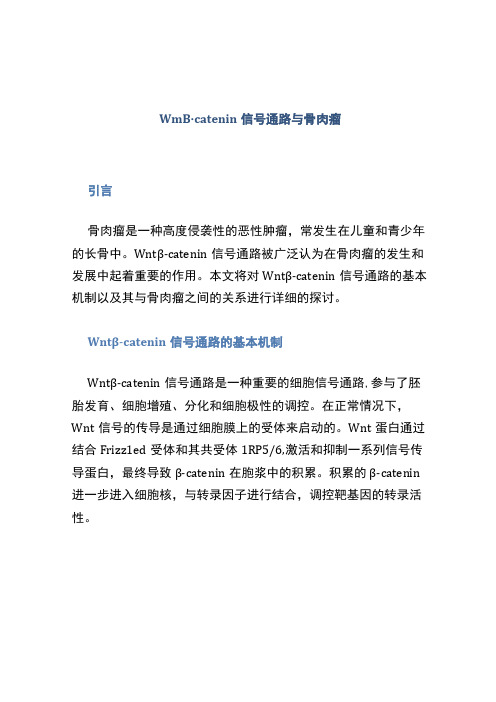
WmB∙catenin信号通路与骨肉瘤引言骨肉瘤是一种高度侵袭性的恶性肿瘤,常发生在儿童和青少年的长骨中。
Wntβ-catenin信号通路被广泛认为在骨肉瘤的发生和发展中起着重要的作用。
本文将对Wntβ-catenin信号通路的基本机制以及其与骨肉瘤之间的关系进行详细的探讨。
Wntβ-catenin信号通路的基本机制Wntβ-catenin信号通路是一种重要的细胞信号通路,参与了胚胎发育、细胞增殖、分化和细胞极性的调控。
在正常情况下,Wnt信号的传导是通过细胞膜上的受体来启动的。
Wnt蛋白通过结合Frizz1ed受体和其共受体1RP5/6,激活和抑制一系列信号传导蛋白,最终导致β-catenin在胞浆中的积累。
积累的β-catenin 进一步进入细胞核,与转录因子进行结合,调控靶基因的转录活性。
Wntβ-catenin信号通路与骨肉瘤的关系Wntβ∙catenin信号通路是骨肉瘤发生和发展的关键信号通路之一。
许多研究表明,Wnt信号通路的活化在骨肉瘤中起着重要的作用。
首先,一些研究发现骨肉瘤患者中Wnt信号通路的成员如Frizz1ed受体、1RP5/6和β-catenin的表达水平明显升高。
其次,Wnt信号通路的激活可以促进骨肉瘤细胞的增殖和侵袭能力,同时抑制细胞凋亡。
最后,抑制Wnt信号可以抑制骨肉瘤细胞的增殖和侵袭,甚至诱导细胞凋亡。
Wntβ-catenin信号通路在治疗骨肉瘤中的应用由于WntB∙catenin信号通路在骨肉瘤中的重要作用,研究人员开始探索利用该信号通路进行骨肉瘤的治疗。
一些研究发现,通过抑制Wnt信号通路的活化,可以抑制骨肉瘤细胞的增殖和侵袭能力,并诱导细胞凋亡。
目前,一些针对Wnt信号通路的靶向药物也已经进入临床试验,展现出一定的治疗潜力。
结论WntB∙catenin信号通路与骨肉瘤之间存在着密切的关系。
该信号通路的活化在骨肉瘤的发生和发展中起着重要的作用,而抑制该信号通路的活化则有望成为骨肉瘤治疗的新策略。
Wnt_catenin信号因子在HepG2以及L02细胞中的表达_王启明
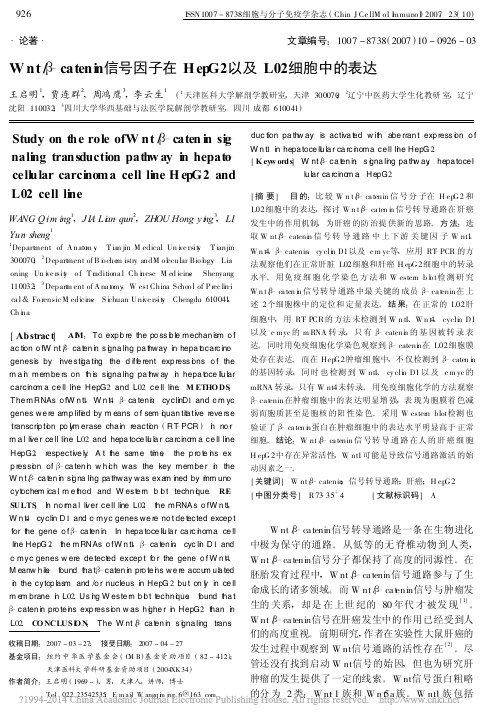
W n t4, cyclin D 1 and cmyc genes we re no t de tected excep t for the gene o f βca ten in . In hepa toce ll u la r ca rc i noma ce ll li ne HepG 2, the mRNAs o fW n t1, βca ten in, cyc li n D 1 and cmyc genes w ere de tected excep t fo r the gene o f W n t4. M eanw h ile, found tha t βcaten in pro te i ns we re accu m ul a ted n the cytop lasm and /o r nucleus in HepG 2 bu t on l i y in ce ll me m brane i n L02. Us i ng W este rn b l o t techn i que, found tha t βcaten in pro te i ns exp ression w as h i ghe r in HepG2 than in L02. CO NCLUS I O N: The W nt /βca ten in s i gna ling trans收稿日期 :2007 - 03 -27; 接受日期 : 2007 - 04 - 27 基金项目 :纽约 中 华医 学基 金 会 ( C M B )基 金资 助 项目 ( 82 - 412); 天津医科大学科研基金资助项目 (2004XK 34) 作者简介 : 王启明 (1969 - ), 男 , 天津人 , 讲师 , 博士 Tel:02223542535;E m ail: W angq i m ing6@ 163 . com
Wnt/β-Catenin信号通路在非酒精性脂肪肝发病中的作用及阿托伐他汀的干预效果
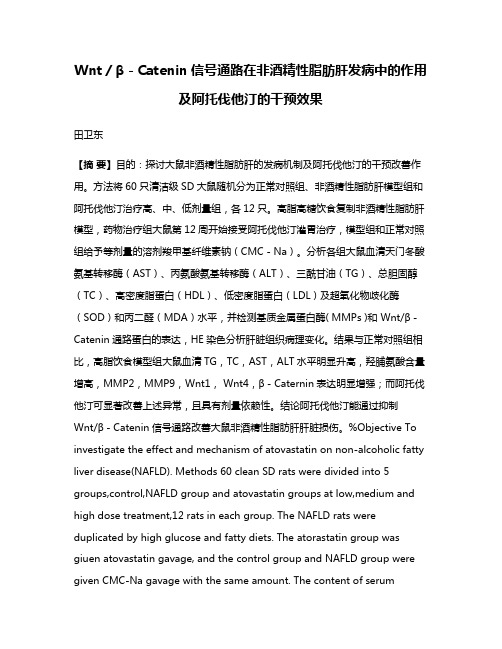
Wnt/β-Catenin信号通路在非酒精性脂肪肝发病中的作用及阿托伐他汀的干预效果田卫东【摘要】目的:探讨大鼠非酒精性脂肪肝的发病机制及阿托伐他汀的干预改善作用。
方法将60只清洁级SD大鼠随机分为正常对照组、非酒精性脂肪肝模型组和阿托伐他汀治疗高、中、低剂量组,各12只。
高脂高糖饮食复制非酒精性脂肪肝模型,药物治疗组大鼠第12周开始接受阿托伐他汀灌胃治疗,模型组和正常对照组给予等剂量的溶剂羧甲基纤维素钠(CMC-Na)。
分析各组大鼠血清天门冬酸氨基转移酶(AST)、丙氨酸氨基转移酶(ALT)、三酰甘油(TG)、总胆固醇(TC)、高密度脂蛋白(HDL)、低密度脂蛋白(LDL)及超氧化物歧化酶(SOD)和丙二醛(MDA)水平,并检测基质金属蛋白酶( MMPs )和Wnt/β-Catenin通路蛋白的表达,HE染色分析肝脏组织病理变化。
结果与正常对照组相比,高脂饮食模型组大鼠血清TG,TC,AST,ALT水平明显升高,羟脯氨酸含量增高,MMP2,MMP9,Wnt1, Wnt4,β-Caternin表达明显增强;而阿托伐他汀可显著改善上述异常,且具有剂量依赖性。
结论阿托伐他汀能通过抑制Wnt/β-Catenin信号通路改善大鼠非酒精性脂肪肝肝脏损伤。
%Objective To investigate the effect and mechanism of atovastatin on non-alcoholic fatty liver disease(NAFLD). Methods 60 clean SD rats were divided into 5 groups,control,NAFLD group and atovastatin groups at low,medium and high dose treatment,12 rats in each group. The NAFLD rats were duplicated by high glucose and fatty diets. The atorastatin group was giuen atovastatin gavage, and the control group and NAFLD group were given CMC-Na gavage with the same amount. The content of serumAST,ALT,TG,TC, SOD and MDA were assayed in each group. The expression of MMPs and Wnt/β-Catenin pathway members were detected by ELISA. The pathological changes of liver tissue were analyzed by HE staining. Results The results showed that the contents of AST, ALT,TG,TC,LDL were increased in NAFLD rats while the HDL concentration was decreased when compared with control. The results also revealed thatMMP2,MMP9,Wnt1,Wnt4 as well as β-Catenin was up-regulated dramatically when compared with the control group. Atovastatin treatment can relieve those aforementioned parameters dramatically with dosage dependence. Conclusion Activated Wnt/β-Catenin is participated in the pathogenesis of NAFLD and atovastatin exerts its effect mainly by inhibiting this pathway.【期刊名称】《中国药业》【年(卷),期】2016(025)004【总页数】4页(P51-53,54)【关键词】非酒精性脂肪肝;阿托伐他汀;Wnt/β-Catenin信号通路;羟脯氨酸;剂量依赖性【作者】田卫东【作者单位】湖北省武汉市江夏区疾病预防控制中心,湖北武汉 430200【正文语种】中文【中图分类】R965;R972+.6随着生活方式及饮食结构的改变,非酒精性脂肪肝的发病率有逐年升高趋势,且严重影响患者的生活质量[1-2]。
Wntβ-catenin信号促进乳腺癌干细胞扩增的下游分子机理研究的开题报告
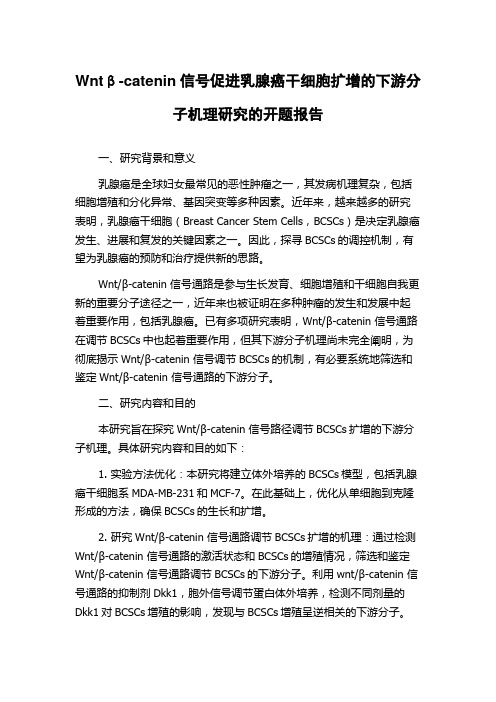
Wntβ-catenin信号促进乳腺癌干细胞扩增的下游分子机理研究的开题报告一、研究背景和意义乳腺癌是全球妇女最常见的恶性肿瘤之一,其发病机理复杂,包括细胞增殖和分化异常、基因突变等多种因素。
近年来,越来越多的研究表明,乳腺癌干细胞(Breast Cancer Stem Cells,BCSCs)是决定乳腺癌发生、进展和复发的关键因素之一。
因此,探寻BCSCs的调控机制,有望为乳腺癌的预防和治疗提供新的思路。
Wnt/β-catenin 信号通路是参与生长发育、细胞增殖和干细胞自我更新的重要分子途径之一,近年来也被证明在多种肿瘤的发生和发展中起着重要作用,包括乳腺癌。
已有多项研究表明,Wnt/β-catenin 信号通路在调节BCSCs中也起着重要作用,但其下游分子机理尚未完全阐明,为彻底揭示Wnt/β-catenin 信号调节BCSCs的机制,有必要系统地筛选和鉴定Wnt/β-catenin 信号通路的下游分子。
二、研究内容和目的本研究旨在探究Wnt/β-catenin 信号路径调节BCSCs扩增的下游分子机理。
具体研究内容和目的如下:1. 实验方法优化:本研究将建立体外培养的BCSCs模型,包括乳腺癌干细胞系MDA-MB-231和MCF-7。
在此基础上,优化从单细胞到克隆形成的方法,确保BCSCs的生长和扩增。
2. 研究Wnt/β-catenin 信号通路调节BCSCs扩增的机理:通过检测Wnt/β-catenin 信号通路的激活状态和BCSCs的增殖情况,筛选和鉴定Wnt/β-catenin 信号通路调节BCSCs的下游分子。
利用wnt/β-catenin 信号通路的抑制剂Dkk1,胞外信号调节蛋白体外培养,检测不同剂量的Dkk1对BCSCs增殖的影响,发现与BCSCs增殖呈逆相关的下游分子。
3. 验证候选下游分子的生物学功能:将筛选到的下游分子,体外表达,检测其对BCSCs的增殖影响,利用定量PCR、Western blot进行检测。
- 1、下载文档前请自行甄别文档内容的完整性,平台不提供额外的编辑、内容补充、找答案等附加服务。
- 2、"仅部分预览"的文档,不可在线预览部分如存在完整性等问题,可反馈申请退款(可完整预览的文档不适用该条件!)。
- 3、如文档侵犯您的权益,请联系客服反馈,我们会尽快为您处理(人工客服工作时间:9:00-18:30)。
Molecular Pharmacology Fast Forward. Published on May 1, 2012 as doi:10.1124/mol.112.078535 MOL#78535Wnt/β-catenin signaling mediates the antitumor activity of magnololin colorectal cancer cellsYou-Jin Kang, Hyen Joo Park, Hwa-Jin Chung, Hye-Young Min, Eun Jung Park, Min Ai Lee,Yoonho Shin, Sang Kook LeeCollege of Pharmacy, Ewha Womans University, 11-1 Daehyun-dong, Seodaemun-gu, Seoul120-750, Korea (Y.J.K., H.Y.M., E.J.P)College of Pharmacy, Seoul National University, San 56-1, Sillim-dong, Gwanak-gu, Seoul151-742, Korea (H.J.P., H.J.C., M.A.L., Y.S., S.K.L)Running Title: Antitumor activity of magnolol through Wnt/β-catenin signalingCorresponding author: Dr. Sang Kook LeeAddress: College of Pharmacy, Seoul National University, San 56-1,Sillim-dong, Gwanak-gu, Seoul 151-742, KoreaTel.: 82. 2. 880. 2475FAX: 82. 2. 762. 8322Email address: sklee61@snu.ac.krNumber of text pages: 32Number of Tables: 0Number of figures: 7Number of references: 35Abstract: 243Introduction: 615Discussion: 1137Abbreviations: APC, adenomatous polyposis coli; CKIα, casein kinase Iα; FBS, fetal bovine serum; Fz, frizzled; GSK3β, glycogen synthase kinase 3β; LRP5/6, low-density lipoprotein-related receptors 5 and 6; MMP, matrix metalloprotease; PSF, penicillin G sodium and streptomycin and amphothericin B; TCF/Lef, T cell factor/lymphoid-enhancing factor; uPA, urokinase-type plasminogen activatorAbstractAbnormal activation of the canonical Wnt/β-catenin pathway and up-regulation of the β-catenin/T-cell factor (TCF) response to transcriptional signaling play a critical role early in colorectal carcinogenesis. Therefore, Wnt/β-catenin signaling is considered an attractive target for cancer chemotherapeutics or chemopreventive agents. Small molecules derived from the natural products were used in our cell-based reporter gene assay to identify potential inhibitors of Wnt/β-catenin signaling. Magnolol, a neolignan from the cortex of Magnolia obovata, was identified as a promising candidate, as it effectively inhibited β-catenin/TCF reporter gene (TOPflash) activity. Magnolol also suppressed Wnt3a-induced β-catenin translocation and subsequent target gene expression in HEK293 cells. To further investigate the precise mechanisms of action in the regulation of Wnt/β-catenin signaling by magnolol, we performed Western blot analysis, real-time reverse transcriptase-polymerase chain reactions, and an electrophoretic mobility shift assay in human colon cancer cells with aberrantly activated Wnt/β-catenin signaling. Magnolol inhibited the nuclear translocation of β-catenin and significantly suppressed the binding of β-catenin/TCF complexes onto their specific DNA-binding sites in the nucleus. These events led to the down-regulation of β-catenin/TCF-targeted downstream genes such as c-myc, matrix metalloproteinase (MMP)-7, and urokinase-type plasminogen activator (uPA) in SW480 and HCT116 human colon cancer cells. In addition, magnolol inhibited the invasion and motility of tumor cells, and exhibited antitumor activity in a xenograft-nude mouse model bearing HCT116 cells. These findings suggest that the growth inhibition of magnolol against human colon cancer cells can be partly attributed to the regulation of the Wnt/β-catenin signaling pathway.IntroductionColorectal cancer is one of the leading causes of cancer-related human morbidity and mortality worldwide. Although surgery is the most effective treatment for advanced colon cancer, recurrence frequently occurs within a few years after surgery. Therefore, it is logical to develop strategies based on the carcinogenic progression of common colorectal cancers to decrease the incidence of colon cancer. The dysregulation of the Wnt/β-catenin signaling pathway has been considered to play an important role in colon carcinogenesis.The Wnt signaling pathway can be divided into two distinct pathways: a canonical signaling pathway mediated by β-catenin and a non-canonical signaling pathway regulated by Ca2+ or small G protein like Rho/Rac (Huelsken et al., 2002). The control of β-catenin levels is a key feature of the canonical Wnt/β-catenin signaling pathway. In the absence of Wnt activation, cytosolic β-catenin is constitutively phosphorylated through casein kinase Iα(CKIα) and glycogen synthase kinase 3β (GSK3β), a component of the β-catenin destruction complex that contains axin and adenomatous polyposis coli (APC) as scaffolding proteins. The phosphorylated β-catenin is subsequently degraded by the β-TrCP-mediated ubiquitin/proteasome pathway (Ikeda et al., 1998; Liu et al., 2005). When Wnt proteins are present, they bind to the Frizzled (Fz) receptor and to low-density lipoprotein-related receptors 5 and 6 (LRP5/6). These events lead to the dissociation of β-catenin from the APC/axin/GSK3β destruction complex. Consequently, unphosphorylated β-catenin accumulates in the cytoplasm and translocates into the nucleus, where β-catenin interacts with T cell and lymphoid-enhancing factors (TCF/Lef) to activate the transcription of Wnt/β-catenin-mediated target genes (Bienz, 2002; Cong and Varmus, 2004). The target genes include cell-cycle regulating genes (c-myc and cyclin D1) and genes related to metastasis and the invasion of cancer cells (MMP-7 and uPA) (He et al., 1998; Tetsu and McCormick, 1999).Aberrant activation of Wnt signaling has been found in a variety of cancers including colon cancers (Bright-Thomas and Hargest, 2003; Phelps et al., 2009; Shan et al., 2009). In particular, APC mutations are the most prevalent genetic alterations in colorectal cancers and lead to the accumulation of β-catenin. They are also associated with the constitutive activation of the Wnt pathway. Indeed, mutations of APC (present in over 80% of sporadic colon cancers) and/or β-catenin (present in approximately 10% of colon cancers) are found in colon cancers, suggesting that these mutations eventually activate the Wnt pathway in colorectal cancer cells. Thus, the modulation of the Wnt/β-catenin signaling pathway is an attractive candidate for developing a targeted therapy for colorectal cancers.In the present study, we employed a cell-based reporter gene assay to search for novel small molecule inhibitors of the Wnt signaling pathway. We identified magnolol as a potent inhibitor of the Wnt pathway. Magnolol also exhibits anti-proliferative and anti-tumor activity in colon cancer cells with the modulation of the Wnt signaling pathway.Magnolol is one of major components of the cortex of Magnolia obovata Thumb. (Magnoliaceae). M. obovata, a medicinal plant widely distributed in Japan, has been traditionally used for gastrointestinal disorders, constipation and cough. Magnolol has also shown many biological activities, such as antimicrobial, anti-asthmatic, and anti-platelet activities (Clark et al., 1981; Teng et al., 1988; Ko et al., 2003). In addition, anti-proliferative and anti-metastatic effects against various cancer cell lines including colon cancer, hepatoma, leukemia, fibrosarcoma, melanoma, squamous carcinoma, thyroid carcinoma and prostate cancer cells, have also been reported (Zhong et al., 2003; Battle et al., 2005; Ishitsuka et al., 2005; Kong et al., 2005; Huang et al., 2007; Lee et al., 2008). However, the precise mechanism of the inhibition of colon cancer cell growth remains to be identified. Herein, we provide evidence that magnolol may represent a new class of compounds that inhibit the Wntpathway by inhibiting the transcriptional activity of β-catenin/TCF.Materials and methodsCell culture and reagents.Human colorectal carcinoma (HCT116), colorectal adenocarcinoma (SW480), embryonic kidney (HEK293), L cells, and L cells stably transfected with Wnt3a (L-Wnt3a) were obtained from the American Type Culture Collection (Manassas, V A). L cell is used to obtain control conditioned medium for comparison to Wnt3a conditioned medium from L-Wnt3a cells. Cells were grown in the media: Dulbecco’s modified Eagle medium (DMEM) for HEK293 and L cells; DMEM with 100 μg hygromycin for HEK293-hFz1 cells; DMEM with 400 μg G418 for L-Wnt3a cells; and RPMI 1640 for HCT116 cells. These media were supplemented with 10% FBS and antibiotics-antimycotics (PSF; 100 units/ml penicillin G sodium, 100 μg/ml streptomycin, and 250 ng/ml amphothericin B). SW480 cells were grown in RPMI 1640 medium containing 25 mM HEPES, 10% FBS, and PSF.Dulbecco’s modified Eagle medium (DMEM), RPMI 1640 medium, fetal bovine serum (FBS), antibiotics-antimycotics solution, β-catenin specific siRNA and trypsin-EDTA were purchased from Invitrogen (Grand Island, NY). Bovine serum albumin (BSA), trichloroacetic acid, TRI reagent, HEPES, mouse monoclonal anti-β-actin antibody, hygromycin B and other agents unless otherwise indicated were purchased from Sigma-Aldrich (St. Louis, MO). Mouse monoclonal anti-c-myc was purchased from Santa Cruz Biotechnology (Santa Cruz, CA). Mouse monoclonal anti-cyclin D1, anti- β-catenin, anti-PARP and anti-GSK-3β antibodies were purchased from BD Biosciences (San Diego, CA). Complete TM protease inhibitor cocktail was purchased from Roche Applied Science (Penzberg, Germany). Alexa Fluor 488 goat anti-mouse IgG, and SYBR Gold®staining solution were purchased from Molecular Probes (Eugene, OR). Gene-specificprimers for reverse transcriptase-polymerase chain reaction (PCR), real-time PCR and scrambled siRNA were synthesized from Bioneer (Daejeon, Korea). AMV reverse transcriptase, dNTP mixture, oligo (dT)15 primer, RNasin, Taq DNA polymerase, Dual luciferase assay system were purchased from Promega (Madison, MA). TCF-electrophoretic mobility shift assay kit was purchased from Panomics (Redwood City, CA).Test compound. Magnolol (4-Allyl-2-(5-allyl-2-hydroxy-phenyl)phenol, Fig. 1), isolated from Magnolia obovata, was provided by Dr. KiHwan Bae (Chungnam National University, Korea) (purity: >98.5%), and dissolved in 100% dimethyl sulfoxide.Reporter gene assay.Transient transfections were performed using Lipofectamine 2000 (Invitrogen). Briefly, cells (1.5 × 104) were seeded onto 48-well plate. TCF (T cell factor) reporter plasmid contains two sets (with the second set in the reverse orientation) of three copies of the binding site (wild type) upstream of the thymidine kinase (TK) minimal promoter and luciferase open reading frame (TOPflash, pGL3-OT). FOPflash (pGL3-OF) containing mutated TCF binding sites is used as a negative control. After 24 h, the cells were transfected with 0.1 μg of the luciferase reporter constructs (TOPflash or FOPflash, respectively) and 0.005 μg of the Renilla gene for normalization. HEK293 cells were also co-transfected with 0.02 μg pcDNA β-catenin and 0.008 μg of the TCF4 plasmid. After 24 h of transfection, compound was added, and the cells were incubated for 24 h, lysed in 1×Passive Lysis Buffer (Promega), and collected for luciferase and Renilla activity assays. Activity values were normalized to those for Renilla and expressed as the relative value compared to the control.Preparation of Wnt3a conditioned medium. Wnt3a-conditioned medium (Wnt3a-CM) was prepared by culturing Wnt3a-secreting L cells (L-Wnt3a) in DMEM with 10% FBS for four days. The medium was harvested and sterilized using a 0.22-μm filter. Fresh medium was added and the cells were cultured for an additional three days. The medium was collected again and combined with the previous medium.Stable transfection.HEK293 cells (1 × 106 cells/dish in 100 mm dishes) were incubated for 24 h and transfected with the hFz1 plasmid (24 μg, provided by Dr. S. Oh at Inje University, Korea). After 24 h, the cells were harvested and reseeded onto 100 mm dish (1×104 cells/dish). Medium was replaced daily with fresh medium containing 200 μg/ml hygromycin B until cell colonies were visualized. The cell colonies were then detached and reseeded onto 24-well plate. To confirm stable transfection, reporter gene assay was performed in the presence of Wnt3a-CM.Isolation of cytosolic and nuclear extracts.Cells (1ⅹ106 cells) were treated with test compounds for 24 h with or without Wnt3a-CM. Harvested cells were washed with PBS, suspended in ice-cold lysis buffer (10 mM Tris-HCl [pH 8.0], 1.5 mM MgCl2, 10 mM KCl, 0.1 mM EDTA, 1 mM DTT, 2% NP-40, 50 mM sodium fluoride, 5 mM sodium orthovanadate, and protease inhibitor cocktail) on ice for 5 min. After centrifugation at 2,500 rpm for 4 min at 4o C, the supernatant was collected as a cytosolic fraction, and the pellets were washed twice with ice-cold lysis buffer without NP-40. Cells were resuspended in hypertonic nuclear extract buffer (20 mM Tris-HCl [pH 8.0], 420 mM NaCl, 1.5 mM MgCl2, 0.2 mM EDTA, 25% glycerol, 50 mM sodium fluoride, and protease inhibitor cocktail) on ice for 10 min and then centrifuged at 140,000 rpm for 15 min at 4o C. This supernatant, whichcontained nuclear extracts, was collected and stored in aliquots at -70o C. The protein content of the cell lysates was determined using the Bradford assay (Bradford, 1976).Cell proliferation assay. Cells (5 × 103 cells/well in 96 well plates) were incubated for 24 h, and treated with test compound for 24, 48, and 72 h. After incubation, cells were exposed to PreMix WST-1 solution (10 μl/well, Takara, Shiga, Japan) for 2-4 h. Absorbance was measured at 450 nm. Cell viability was determined by comparing the absorbance of vehicle-treated control group.Western blotting. Cells were treated with test compound for 24 h. Harvested cells were disrupted and protein contents were measured by the Bradford assay. Equal amount (40-80 μg) of protein samples were subjected to 6-15% SDS-PAGE. Separated proteins were transferred to PVDF membranes (Millipore, Bedford, MA). Membranes were incubated with primary antibodies diluted in 3% non-fat dry milk in PBST (1:200-1:2000) overnight at 4o C, washed three times with PBST, and incubated with corresponding secondary antibodies. The blots were detected with an enhanced chemiluminescence detection kit (LabFrontier, Suwon, Korea) and a LAS 3000 Imager (Fuji Film Corp., Tokyo, Japan).Reverse transcription- and real-time polymerase chain reaction.HEK293 cells (4 ×105 cells/dish in 60-mm dishes) were transfected with 2 μg pcDNA β-catenin for 24 h, and then cells were treated with test compound for 12 h. Total RNA was extracted using TRI®reagent and reverse transcribed with AMV reverse transcriptase and the oligo(dT)15 primer. Polymerase chain reaction (PCR) was performed in a mixture containing cDNA, 0.2 mM dNTP mixture, 10 pmol of gene-specific primers, and 0.25 units of Taq DNA polymeraseusing a GeneAmp PCR System 2400 (Applied Biosystems, Foster, CA). The PCR cycling parameters used are as follows: an initial denaturation step for 4 min at 94o C; 25-30 cycles of amplification, consisting of denaturation for 30 sec at 94o C, annealing for 30 sec at 55-57o C, and elongation for 30 sec at 72o C; and a final extension step for 5 min at 72o C. The PCR products were separated by 2% agarose gel electrophoresis. The gel was stained with a SYBR Gold staining solution, and visualized under a UV transilluminator (Alpha Imager TM, Alpha Innotech Corp., Santa Clara, CA). PCR primer sequences are listed (Supplemental Table 1).Real-time PCR was conducted with a MiniOpticon system (Bio-Rad, Hercules, CA), using 5 μl of reverse transcription product, iQ TM SYBR® Green Supermix (Bio-Rad), and primers for a total volume of 20 μl. The standard thermal cycler conditions were employed: 95°C for 20 s, 40 cycles of 95°C for 20 s, 56°C for 20 s, and 72°C for 30 s, followed by 95°C for 1 min, and 55°C for 1 min. The threshold cycle (C T), the fractional cycle number at which the amount of amplified target gene reaches a fixed threshold, was determined using by MJ Opticon Monitor software. The mean threshold cycle (Ct) value for each transcript was normalized by dividing it by the mean Ct value for the β-actin transcript for that sample. Normalized transcript levels were expressed relative to sample obtained from control. Real-time PCR primer sequences are listed (Supplemental Table 1).Immunofluorescence. Cells were plated onto coverslips and incubated for 24 h. After incubation with test compound for 24 h, the cells were fixed with a 4% paraformaldehyde solution for 30 min at room temperature. The cells were then treated with a 0.1% Triton X-100 solution for permeabilization. After quenching with a 0.1% sodium borohydrate solution, the coverslips were blocked with blocking buffer (1% bovine serum albumin and 0.01% sodium azide in PBS) for 1 h. The coverslips were subsequently incubated with β-cateninantibodies diluted in blocking buffer (1:250) overnight at 4o C. The coverslips were further incubated with the corresponding fluorescence (Alexa Fluor 488)-labeled secondary antibodies for 1-2 h. The coverslips were washed three times with PBS, and then mounted with Prolong Gold® antifade agent (Molecular Probes, Eugene, OR). Fluorescence-labeled cells were observed under the confocal fluorescence microscope (LSM 510 META, Carl Zeiss, Germany).Electrophoretic mobility shift assay.The binding of activated TCF and the sequence of the TCF response element were evaluated using the TCF-electrophoretic mobility shift assay kit. Activated TCF was prepared as nuclear cell extracts from SW480 cells. Binding reactions containing 8 μg extracted protein and 1.5 pmol biotin-labeled TCF binding probe were performed for 30 min at 15o C. The products were separated on 6% non-denaturing polyacrylamide gels, and visualized using an ECL detection system.Cell invasion and motility assay. HCT116cells (5 x 104 cells/chamber) were used for invasion and motility assays. The inner and outer surface on the filter membrane of Transwell® (Corning) were coated with 10 μl of type I collagen (0.5 mg/ml) and 20 μl of 1:2 mixture of Matrigel:DMEM, respectively. Cells were plated on the upper chamber of the Matrigel-coated Transwell®. The medium of the lower chambers was also contained 0.1 mg/ml bovine serum albumin. The inserts were incubated for 24 h at 37ºC. The cells that had invaded the outer surface of the membrane were fixed with methanol and stained with hematoxylin and eosin, and photographed.To determine the cell motility, cells were seeded into Transwell® on the outer surface ofthe filter membrane coated with type I collagen. After incubation for 24 h, the membraneswere fixed, stained, and photographed as described previously.RNA interference. RNA interference of β-catenin was performed using siRNA duplexes purchased from Bioneer (Daejeon, Korea). The sequence of the β-catenin siRNA was AUUACUAGAGCAGACAGAUAGCACC, and GGUGCUAUCUG UCUGCUCUAGUAAU for the sense and antisense strands, respectively. SW480 cells (2 ×105 cells/well in 6-well plate) were transfected with 10 nM of the siRNA duplexes using RNAiMAX (Invitrogen) according to the manufacturer’s recommendations. Cells were also transfected with nonspecific control siRNA duplex for direct comparison. After 24 h of transfection, cells were collected, and the protein expression was determined using Western blotting.In vivo tumor xenograft study.Female nude mice (five weeks old, BALB/cA-nu[nu/nu]) were purchased from Central Laboratory Animal Inc. (Seoul, Korea), and acclimatedfor one week at 22 ± 2°C with a 12 h light/dark cycle in a pathogen-free environment. Allanimal experiments and care were conducted in a manner conforming to the Guidelines of theAnimal Care and Use Committee of Ewha Womans University (permission number:EWHA2009-2-13). HCT116 cells were injected subcutaneously into the flanks of the mice(2ⅹ106 cells in 200 μl medium), and tumors were allowed to develop for eight days until theyreached approximately 80 mm3. The mice were randomized into vehicle control and treatment groups (n=5). Magnolol (5 mg/kg/body weight) was intraperitoneally injected in asolution containing 0.5% ethanol and 0.5% cremophor (ethanol : cremophor : H2O = 0.5 :0.5 : 99) in a volume of 200 μl three times a week. The control group was treated with an equal volume of vehicle. Tumor volume was measured using calipers according to the following formula: tumor volume (mm3) = 3.14 ×L ×W ×H / 6, where L is the length, W is the width, and H is the height.Statistical analysis. Data are expressed as means ± standard deviation (SD) for the indicated number of independently performed experiments. Student's t-test (SigmaStat 3.1, Systat software Inc.) was used for the determination of statistical significance. The difference was considered to be statistically significant when P <0.05.ResultsInhibitory effects of magnolol on β-catenin/TCF signaling. To search for small molecule inhibitors of β-catenin/TCF signaling, a TOPflash assay was employed. In our evaluation of approximately five hundred natural compounds magnolol was identified as one of the most potentially active compounds in this assay system (Fig. 1A). Magnolol (Fig. 1A) exhibited potent inhibitory activity against the TOPflash reporter gene in a concentration-dependent manner (Fig. 1B). However, magnolol did not affect FOPflash activity (a mutant of the TCF binding site), suggesting that the inhibitory activity by magnolol is dependent on β-catenin/TCF signaling. To further elucidate whether the inhibitory activity of β-catenin/TCF signaling by magnolol is associated with target gene expression, downstream target genes, such as cyclin D1 or c-myc, were investigated with RT-PCR or real-time PCR analysis. Under normal conditions, the β-catenin level in HEK293 cells is relatively low, and thus, the expression of target genes is maintained at a low level. However, the introduction of the β-catenin plasmid remarkably increased the expression of cyclin D1 and c-myc genes,target genes of β-catenin/TCF signaling. The elevated expression of the target genes by β-catenin was alleviated upon treatment with magnolol (Fig. 2A). Real-time PCR analysis also showed the downregulation of cyclin D1 and c-myc gene expressions after treatment with magnolol in a concentration-dependent manner (Fig. 2B). In addition, target protein expression, specifically, the expression of the cyclin D1 and c-myc proteins, was investigated in β-catenin-overexpressing cells. HEK293 cells were transfected with the β-catenin plasmid (1.5 μg) for 24 h and then treated with magnolol for an additional 24 h. As shown in Fig. 2C, magnolol suppressed the expression of the cyclin D1 and c-myc proteins. These results suggest that magnolol suppressed the expression of cyclin D1 and c-myc through the inhibition of the β-catenin/TCF signaling pathway.Inhibitory effects of magnolol on Wnt/β-catenin signaling in HEK293-hFz1 cells. Under normal conditions, APC/Axin/GSK3 destruction complexes phosphorylate β-catenin, and the phosphorylated β-catenin is recognized by β-TrCP and then subsequently degraded by the ubiquitin-proteasomal pathway. As a result, cytosolic β-catenin levels are maintained at a low level. In the presence of Wnt, the destruction complex is dissociated and cytosolic β-catenin is translocated into the nucleus to activate the target genes. To confirm the responsiveness of Wnt/β-catenin signaling, various concentrations of Wnt3a-CM which were conditioned from Wnt3a-producing L cells were treated and the TOPflash reporter gene assay was performed. Treatment with 50 and 100% of Wnt3a-CM increased luciferase activity approximately three-fold compared to that of the non-treated control (Supplemental Fig. 1A). Based on these findings, we further established HEK293-hFz1 cells, which were anchored with the Wnt receptor human frizzled-1, to enhance the responsiveness of Wnt signaling. Wnt3a-CM remarkably increased the TOPflash activity in HEK293-hFz1 cells compared toHEK293 cells (Supplemental Fig. 1B). The activation of Wnt-mediated signaling in HEK293-hFz1 cells was also confirmed by a significant increase in β-catenin expression in the cytoplasm and nucleus (Supplemental Fig. 1C). To evaluate whether magnolol suppresses Wnt/β-catenin-mediated transcriptional activity in HEK293-hFz1 cells the TOPflash activity and target gene expression were determined in Wnt3a-CM-treated HEK293-hFz1 cells. As shown in Fig. 3A, Wnt3a-CM markedly increased TOPflash activity, but magnolol abrogated the reporter gene activity in a concentration-dependent manner. Western blot analysis also demonstrated the suppression of the expression of target gene cyclin D1 by magnolol in Wnt3a-CM-treated HEK293-hFz1 cells (Fig. 3B).To further elucidate the effect of magnolol on the expression level of Wnt-induced β-catenin, HEK293-hFz1 cells were treated with Wnt3a-CM in the presence or absence of magnolol for 24 h. Wnt3a-CM enhanced the expression of β-catenin in the cytosol and nucleus, and magnolol suppressed the Wnt3a-CM-induced expression of β-catenin in these cells (Fig. 3C). Because the increase of the degradation of β-catenin in the cytosolic fraction was not found by magnolol, the suppression of β-catenin in the nucleus fraction might be mainly associated with the inhibition of the nuclear translocation of β-catenin by magnolol. Immunofluorescence analysis also revealed the downregulation of β-catenin by magnolol in the Wnt3a-CM-induced HEK293-hFz1 cells (Fig. 3D).Inhibitory effects of magnolol on the β-catenin/TCF signaling pathway in colorectal cancer cells.Based on the findings that magnolol suppressed Wnt3a-induced β-catenin and its target gene expression in HEK293-hFz1 cells, we further explored the effects of magnolol on β-catenin/TCF signaling in colon cancer cells. Colon cancer cells frequently possess mutations in APC or β-catenin and activated Wnt signaling as a result of the cellularaccumulation of β-catenin. To investigate the inhibitory effect of magnolol on the transcriptional activity of β-catenin/TCF in colon cancer cells, the TOPflash reporter gene assay was performed in SW480 (truncated mutation of APC and wild-type β-catenin) or HCT116 (Ser45 deletion mutation of β-catenin and wild-type APC) human colon cancer cells. As shown in Fig. 4A, cells transfected with the TOPflash reporter showed the highest transcriptional activity, but magnolol suppressed the luciferase activity in human colon cancer cells.To further clarify whether the suppressive effect of magnolol on the transcriptional activity of β-catenin/TCF is associated with the downregulation of β-catenin, β-catenin levels in the cytosol and nucleus were examined. When treated with magnolol for 24 h, magnolol suppressed the expression of β-catenin in the cytosol and nucleus in SW480 cells (Fig. 4B). Because magnolol decreased the expression of β-catenin in the nucleus of SW480 cells, it was assumed that the suppressive effect of magnolol on the transcriptional activity of β-catenin/TCF might be correlated with the decrease in the binding of β-catenin/TCF complexes to the promoter region of DNA. Therefore, the change in DNA-TCF complex binding was investigated using an electrophoretic mobility shift assay. Magnolol inhibited the binding of DNA and TCF through the TCF binding site (Fig. 4C). These findings suggest that the suppressive effects of magnolol on β-catenin/TCF transcription are associated with the downregulation of β-catenin in the cytosol and nucleus and consequently the inhibition of binding between DNA and β-catenin/TCF complexes.Inhibitory effect of magnolol on target gene expressions, and cell invasion and migration activity in colon cancer cells.To assess the inhibitory effects of magnolol on β-catenin/TCF signaling in colon cancer cells, real-time PCR was employed to determine theexpression of β-catenin/TCF target genes. Cyclin D1 and c-myc genes are established target genes of the β-catenin-dependent pathway and are implicated in enhancing cell proliferation (He et al., 1998; Liu et al., 2001).As shown in Fig. 5A, treatment with magnolol suppressed the mRNA expression of cyclin D1 and c-myc. Further experiments showed that the expression of matrix metalloproteinase-7 (MMP-7) and urokinase plasminogen activator (uPA), which are associated with cancer cell invasiveness and also target genes of β-catenin/TCF transcription (Brabletz et al., 1999; Alexander et al., 2002), were also significantly suppressed by magnolol (Fig. 5B).Magnolol also suppressed the protein expressions of cyclin D1 and c-myc, but the expression of GSK3β was not altered. However, magnolol remarkably induced the expression of E-cadherin (Fig. 5C). In addition, magnolol dose-dependently inhibited the cancer cell invasion and motility through Transwell® (Fig. 5D).To further confirm whether magnolol regulates cyclin D1 and c-myc through β-catenin/TCF signaling the direct effect of β-catenin siRNA was determined. SW480 cells were transfected with either β-catenin-specific siRNA or scrambled siRNA for 24 h, and then cells were incubated for an additional 24 h in serum-free media. The cells were treated with magnolol for 3 h, and then Western blotting was performed with cell lysates. Transfection with the β-catenin siRNA effectively suppressed the protein expression of β-catenin. The expression of cyclin D1 and c-myc was also decreased by β-catenin siRNA. The expression of c-myc was dramatically suppressed compared to cyclin D1. However, magnolol enhanced the suppression of cyclin D1 expression in cells transfected with β-catenin siRNA in a concentration-dependent manner (Fig. 6).。
